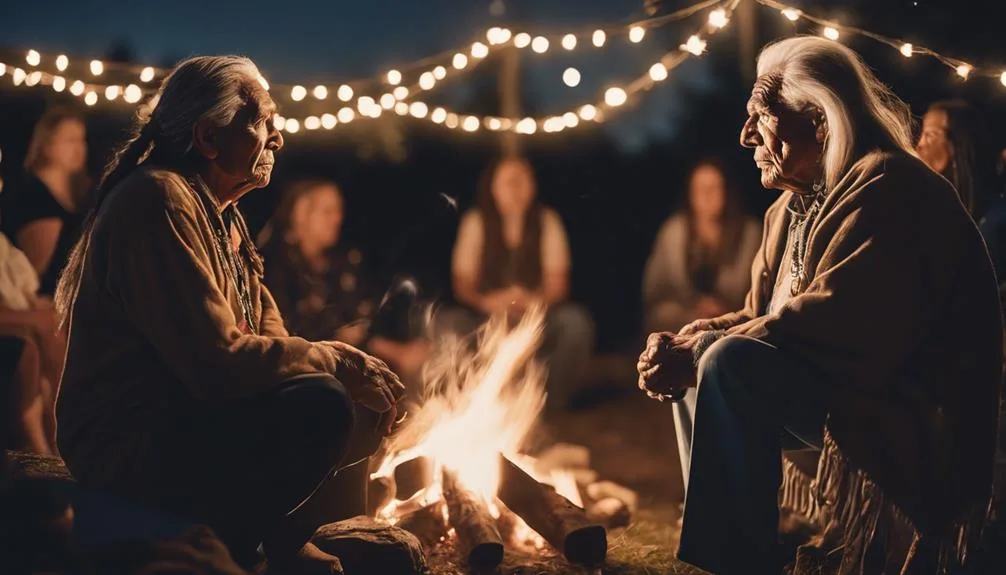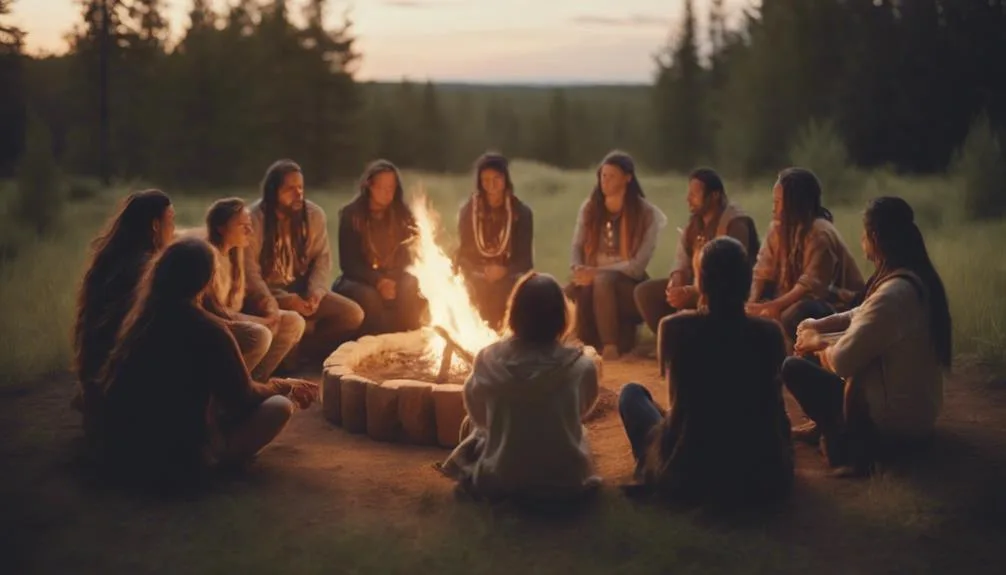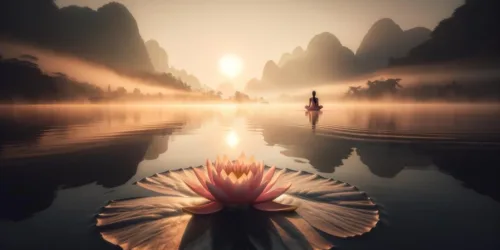Mindfulness Practices in Native American Traditions: A Deep Dive
As you explore the Vision Quest, a pivotal rite of passage in many Native American cultures, you'll uncover its profound impact on mindfulness and personal growth. This ancient practice, involving solitude and fasting in nature, serves as a perfect example of the deep-rooted connection between Native American traditions and mindfulness.
It's not just about the individual's journey; it's about understanding the interconnectedness of all life, a principle that modern mindfulness practices often seek to cultivate. But how exactly do these traditional practices complement contemporary mindfulness approaches, and what can we learn from them about healing and mental well-being?
Join us as we uncover these connections, offering insights that may transform your perspective on mindfulness.
Key Takeaways
- Native American mindfulness emphasizes connection to nature, spirituality, and community well-being.
- Practices include vision quests, sweat lodge rituals, and storytelling, fostering spiritual growth and healing.
- Mindfulness aids in stress reduction, emotional resilience, and recovery from historical trauma.
- Adaptation involves integrating traditional practices with modern therapy and technology while preserving cultural authenticity.
Historical Overview
Rooted deeply in centuries-old traditions, Native American mindfulness practices have evolved amidst a backdrop of both reverence and resilience, reflecting an enduring connection to nature and spirituality. These practices, integral to traditional Indigenous cultures, emphasize silence, respect, harmony, and balance, focusing on holistic well-being. You'll find that mindfulness in Native American traditions isn't just about personal health; it's a profound expression of interconnectedness with the environment and a method for maintaining cultural continuity.
However, it's crucial to understand that historical trauma from colonization has deeply impacted Native American communities. This intergenerational trauma disrupted the transmission of cultural practices, including mindfulness. Yet, in the face of these challenges, there's been a resurgence of interest in traditional mindfulness practices. This revival isn't merely about reclaiming heritage; it's a powerful tool for healing, offering resilience against the ongoing effects of past injustices.
Mindfulness practices in Native American traditions present a unique perspective on mental health, blending cultural heritage with modern therapeutic approaches. They offer a path for both individuals and communities to navigate the complexities of contemporary life while staying rooted in the wisdom of their ancestors.
Vision Quest Significance
As you explore the significance of vision quests in Native American cultures, you'll uncover their origins, which root deeply in traditions aimed at fostering a profound spiritual connection and guidance.
Through examining the ritual steps, you understand the meticulous preparation and personal dedication required, highlighting the quest's role in facilitating transformative journeys.
This exploration reveals not only the quest's importance in personal growth and healing but also its place in sustaining the communal and spiritual fabric of Native American societies.
Vision Quest Origins
Delving into the origins of vision quests reveals their profound significance as transformative ceremonies within Native American cultures, guiding individuals through pivotal moments of self-discovery and spiritual enlightenment. These sacred ceremonies are rooted in traditional healing practices, embodying the essence of Indigenous contemplative methods.
By seeking solitude and fasting in nature, participants dive deep into an introspective journey, connecting with their inner selves, ancestors, and the natural world. Guided by elders or spiritual leaders, the vision quest becomes a conduit for dreams, visions, and profound insights.
This highly personal and transformative experience not only shapes the individual's sense of self but also their purpose within the community, offering clarity, healing, and direction in life.
Ritual Steps Explained
Exploring the Vision Quest further reveals the structured ritual steps that underscore its significance as a profound journey of self-discovery and spiritual connection within Native American cultures. As a cornerstone among ceremonies and traditional spiritual practices, the Vision Quest represents more than an isolated event; it's a transformative passage deeply rooted in Native American wisdom.
- Fasting and Prayer: Participants abstain from food to cleanse the body and mind, using prayer to seek guidance.
- Solitude in Nature: Time alone in wilderness areas facilitates a deep connection with the natural and spiritual worlds.
- Receiving Visions: The quest's pinnacle involves receiving visions or guidance, symbolizing rebirth and spiritual awakening.
This ritual embodies a powerful tool for personal growth, emphasizing the interconnectedness of individual, community, and the natural world in Native American spirituality.
Personal Transformation Journey
Embarking on a Vision Quest marks a significant journey into oneself, where participants actively seek spiritual guidance and personal transformation within the embrace of nature. This traditional Native American ceremony, involving fasting, prayer, and solitude, serves as a profound rite of passage. You're not merely seeking answers; you're connecting with your inner self, ancestors, and the natural world, aiming for clarity and purpose in your life.
The Vision Quest's essence lies in its ability to foster deep self-reflection, challenge fears, and confront personal obstacles, facilitating a transformative experience. It's a sacred practice, deeply embedded in Native American spirituality, offering a unique pathway to personal growth. Engaging in this powerful tradition, you're invited to commune with the spiritual realm, receive visions, and gain insights, charting a course for your personal transformation journey.
Sweat Lodge Rituals
As an integral part of their spiritual and cultural heritage, many Native American tribes practice sweat lodge rituals, where participants enter a dome-shaped structure to undergo a process of purification, healing, and spiritual renewal through intense heat and steam. This practice isn't just a ceremonial act but a deeply ingrained tradition that connects individuals to both the natural world and the spiritual realm. It's a testament to the resilience and richness of Indigenous traditional cultural practices.
To truly appreciate the depth and significance of sweat lodge rituals, consider these key aspects:
- Purification and Healing: The intense heat and steam facilitate a physical and spiritual cleansing, allowing participants to shed impurities.
- Connection to Nature: The use of natural elements like fire-heated stones and water to create steam underscores a profound respect and bond with the earth.
- Spiritual Renewal: Beyond physical detoxification, this ritual serves as a journey for spiritual awakening and introspection, fostering a deeper sense of community and self-awareness.
Understanding sweat lodge rituals offers a window into the complex and rich tapestry of Native American cultural practices, highlighting the enduring legacy and wisdom of Indigenous traditions.
Storytelling and Mindfulness

Building on the rich traditions of sweat lodge rituals, storytelling in Native American cultures serves as another profound practice of mindfulness, deeply connecting individuals to their heritage and the world around them. Through the art of storytelling, you're invited to engage in deep listening, allowing yourself to be fully present and immersed in the narrative. This practice fosters a powerful sense of connection to the natural world, your community, and the shared human experience.
Storytelling in Native American traditions is not just about recounting tales; it's a vehicle for passing down wisdom, embracing the present moment, and honoring the interconnectedness of all living beings. By participating in story circles and embracing oral traditions, you become part of a continuum of knowledge and awareness that extends beyond the individual.
| Aspect of Mindfulness | How Storytelling Enhances It |
|---|---|
| Presence | Engages listeners to be fully present and attentive. |
| Connection | Fosters a deep sense of unity with nature and community. |
| Heritage | Honors ancestors and traditions through narrative. |
In this way, storytelling transcends mere entertainment, becoming a vital practice of mindfulness within Native American traditions, enriching both the individual and the community.
Earth-Centered Practices
As you explore earth-centered practices within Native American traditions, you'll find that the sacred connection to the land is paramount. Seasonal rituals underscore the importance of living in harmony with nature's cycles, while the use of plant medicine highlights a profound understanding of the Earth's healing powers.
These practices not only foster mindfulness but also reinforce a deep respect for the interconnectedness of all life.
Sacred Land Connection
Native American traditions deeply embed the practice of honoring and connecting with the Earth, recognizing it as a living entity through various earth-centered practices. These Indigenous practices emphasize a sacred land connection that isn't just about the physical space but a profound spiritual relationship. This connection is cultivated through rituals, ceremonies, and teachings that underscore the Earth's significance as a source of life, wisdom, and sustenance.
- Rituals and ceremonies that honor the Earth's cycles and elements, fostering a deep respect and gratitude.
- Grounding exercises that help individuals connect with the Earth's energy, promoting mindfulness and presence.
- Environmental stewardship teachings that advocate for sustainability and living in harmony with nature, highlighting the reciprocal relationship between humans and the Earth.
These practices underscore the importance of a sacred land connection in maintaining balance, health, and well-being.
Seasonal Rituals Importance
Seasonal rituals hold a pivotal place in Indigenous cultures, serving as a bridge between the community and the Earth's natural rhythms. Rooted in Earth-centered practices, these ceremonies are not merely traditional acts but essential elements that weave together the fabric of cultural identity, spiritual connection, and environmental harmony. You're engaging in a timeless tradition that honors the Earth's cycles and celestial events, from solstices and equinoxes to planting seasons. These rituals embody gratitude, seek balance, and foster a profound connection with the land.
| Aspect | Importance |
|---|---|
| Nature's Cycles | Aligns community activities with natural and celestial events. |
| Gratitude & Balance | Expresses thanks and seeks harmony with nature. |
| Cultural Identity | Maintains and strengthens the sense of belonging and heritage. |
| Spiritual Connection | Deepens the relationship between individuals and the natural world. |
| Environmental Harmony | Promotes sustainable practices and respect for the Earth. |
Plant Medicine Utilization
Delving into the heart of Indigenous traditions, one finds that the sacred use of herbs, roots, and plants for healing and spiritual purposes isn't only a practice but a profound testament to the interconnectedness of life. In Native American traditions, plant medicine embodies earth-centered healing practices, deeply rooted in a respect for nature's wisdom and the land.
- Traditional healers skillfully gather, prepare, and administer these natural remedies in rituals, emphasizing the role of spiritual and ancestral guidance.
- Cultural protocols govern the use of plant medicines, ensuring respect for the plants and the traditions themselves.
- Interconnectedness with nature reflects a holistic approach to health, recognizing the healing power of the earth and its ability to restore balance.
Understanding these practices offers a glimpse into the depth of Native American healing traditions, where plant medicine serves as a bridge between the physical and spiritual realms.
The Role of Elders
In Native American traditions, elders are revered as the custodians of wisdom and cultural heritage, playing an indispensable role in educating the younger generations. They're not just holders of age but are seen as living libraries, carrying the practices and traditional knowledge essential for the community's spiritual and cultural survival.
Elders lead by example, embodying mindfulness in their daily lives and teaching through actions as much as through words. Their guidance in ceremonies, storytelling, and healing rituals is pivotal, offering a direct link to the ancestral past and ensuring the continuity of these practices into the future.
You'll find that their presence is more than just symbolic; it's a vital connection to the roots that ground the community. They serve as mentors, imparting lessons that are not only about cultural retention but also about personal growth and understanding.
| Role of Elders | Impact on the Community |
|---|---|
| Wisdom keepers | Preserve cultural heritage |
| Mentors | Guide personal growth |
| Leaders in ceremonies | Facilitate spiritual connection |
| Storytellers | Pass down traditional knowledge |
| Healers | Maintain communal well-being |
Their teachings foster a deep respect for the interconnectedness of life, emphasizing the importance of balance, respect, and gratitude. Through their wisdom, the fabric of Native American mindfulness practices is continually woven, passed from one generation to the next.
Community and Connection

At the heart of Native American mindfulness practices, community and connection stand as pillars, fostering a deep sense of interdependence and support. You'll find that in these traditions, the fabric of mindfulness is woven with threads of interconnectedness, not just among individuals, but with nature and ancestors as well. This holistic approach enhances spiritual well-being, creating a resilient and supportive environment for all members.
- Connection to Nature and Ancestors: Vital for spiritual well-being, this connection grounds individuals, reminding them of their place within the larger web of existence.
- Traditional Ceremonies and Rituals: These gatherings are more than just events; they're opportunities for community bonding and shared mindfulness experiences, reinforcing the communal ties.
- Healing and Resilience: Mindfulness practices offer pathways to healing, both individually and collectively, nurturing resilience and cultural preservation.
Modern Adaptations
As Native American communities navigate the complexities of the modern world, they've skillfully adapted mindfulness practices to bridge ancestral wisdom with contemporary life, ensuring these traditions remain relevant and supportive. These modern adaptations are not just about preserving the past; they're about enhancing mental health and well-being in the present moment, recognizing the unique challenges faced by Indigenous communities today.
| Traditional Practice | Modern Adaptation |
|---|---|
| Ceremonial rituals | Therapeutic sessions incorporating ritual elements |
| Oral storytelling | Digital storytelling for broader reach |
| Nature-based mindfulness | Environmental mindfulness programs |
| Communal gatherings | Virtual community support groups |
| Ancestral teachings | Culturally tailored mindfulness curricula |
This table illustrates the seamless integration of timeless practices with innovative approaches, underscoring a harmonious balance between heritage and innovation. Such adaptations ensure mindfulness practices remain deeply rooted in cultural relevance, respecting tribal values and beliefs while addressing contemporary mental health needs. By weaving the threads of the past with the fabric of the present, Indigenous communities demonstrate resilience and adaptability, ensuring their mindfulness practices continue to thrive and support well-being in the modern era.
Frequently Asked Questions
What Is the Indigenous Perspective on Mindfulness?
From an indigenous perspective, mindfulness isn't just a practice; it's a way of life, deeply rooted in cultural rituals, spiritual connections, and ancestral teachings, offering a profound, interconnected way to experience the world.
How Do You Meditate Like a Native American?
To meditate like a Native American, you'd immerse yourself in nature, embracing spiritual rituals and ancestral teachings. Focus on the interconnectedness of all life, practicing gratitude and mindfulness through silence, drumming, or chanting.
Which Cultures Practice Mindfulness?
Mindfulness isn't just a drop in the ocean of cultures; it spans from Eastern philosophies to Western adaptations. Critics often debate its commercialization, yet its essence remains pivotal in understanding self and society.
What Is Neurodecolonization?
Neurodecolonization benefits you by using trauma recovery methods and cognitive shift strategies to heal from colonization's effects. It focuses on rebuilding resilience, promoting well-being, and addressing historical trauma through Indigenous healing practices.
Conclusion
You've journeyed through the sacred landscapes of Native American mindfulness, where ancient rituals meet modern healing. In the dance of tradition and innovation, you've seen how sweat lodges and vision quests, deeply rooted in the past, offer insights for today's challenges.
Elders' wisdom intertwines with earth-centered practices, nurturing a community's soul. This exploration isn't just a study; it's an invitation to weave these enduring threads into the fabric of contemporary mindfulness. Embrace this fusion, where ancestral knowledge illuminates the path to well-being.






